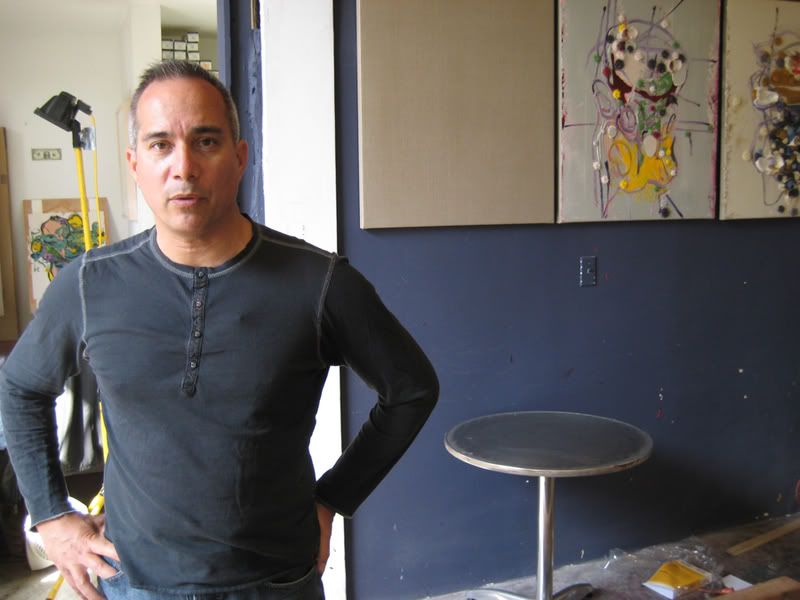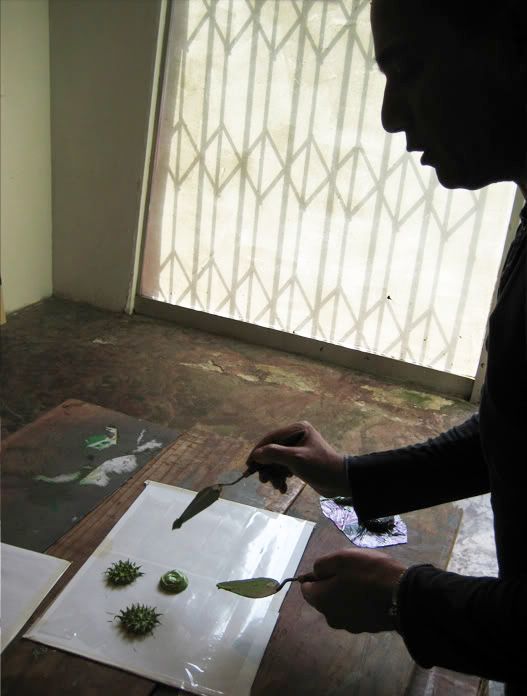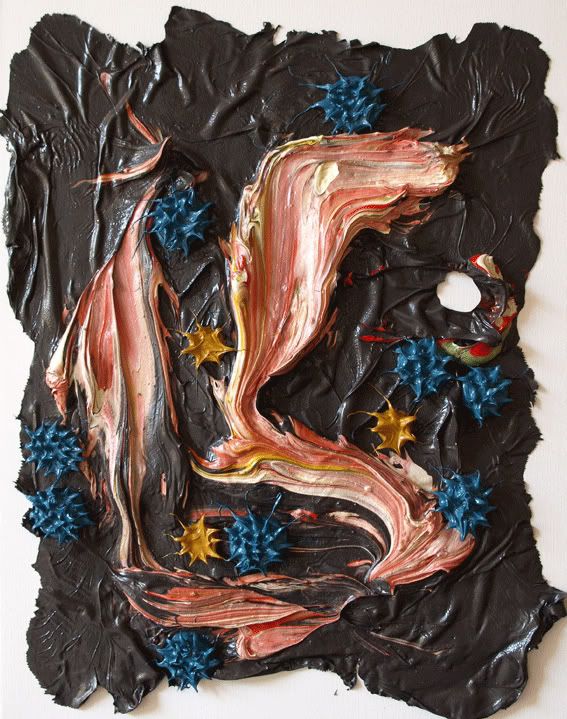 Dennis Hollingsworth
Dennis Hollingsworth It's fortuitous that Dennis Hollingsworth's show of new paintings at Michael Kohn gallery has arrived at the same moment that my investigation into the cthonic roots of shamanic epistemology has taken me into a study of the hermetic tradition of alchemy. Alchemy is a word that we don't often use in the sober, and leavened conversation of contemporary secular humanism, indeed it would appear to rest on the dusty shelves of historical curiosity for many as a zany misadventure and naive attempt to grasp the finer more elegant ratiocinations of scientism that, concurrent with a legion of progressive notions in both social and philosophical domains, arrived en masse as a wave of rational materialism pushed forth out of enlightenment thought and catapulted us into the mantic present. At first blush, alchemy not only appears to occupy the worldview of a less sophisticated time, but also seems to emerge from a milieu that we generally regard with suspicion and contempt: the world of tricksters and legerdemain, charlatans and raconteurs. How on earth can the invocation of alchemy possibly be now all the sudden relevant and without guile?
It's fortuitous that Dennis Hollingsworth's show of new paintings at Michael Kohn gallery has arrived at the same moment that my investigation into the cthonic roots of shamanic epistemology has taken me into a study of the hermetic tradition of alchemy. Alchemy is a word that we don't often use in the sober, and leavened conversation of contemporary secular humanism, indeed it would appear to rest on the dusty shelves of historical curiosity for many as a zany misadventure and naive attempt to grasp the finer more elegant ratiocinations of scientism that, concurrent with a legion of progressive notions in both social and philosophical domains, arrived en masse as a wave of rational materialism pushed forth out of enlightenment thought and catapulted us into the mantic present. At first blush, alchemy not only appears to occupy the worldview of a less sophisticated time, but also seems to emerge from a milieu that we generally regard with suspicion and contempt: the world of tricksters and legerdemain, charlatans and raconteurs. How on earth can the invocation of alchemy possibly be now all the sudden relevant and without guile? Dennis making a "monad"
Dennis making a "monad"Lately I've been reading a great deal about a widespread cultural schizophrenia- a discomforting cloud of confusion and uncertainty that seems to have descended upon us without warning. It's like we are adrift from ourselves, floating in a dissociative and numbing space of repetition, reduction, and denial. And it's not only in the art world that I feel these vibes, it's all around us, this pervasive vacuum of self. We're like drifters, amnesiacs, wandering mumbling through the streets, foraging through trash heaps and peering into other peoples lives in search of who we are to be, what we are to do in the face of the many challenges that lie in the future and that now have begun to cast an enormous shadow backwards in time. In our zeal to embrace the conceptual and the everyday, we have become disconnected from the spiritual path. If our souls are in fact able to be imagined at all, they are like ghosts in the network, disembodied, disincarnate, only evidenced by the transfer of information from one node to another- but never to be found, only adduced.

If we are to re-imagine a self that it is not disconnected and forlorn, if we are to follow our appetition for oneness and discard the meretricious cultural diversions that surround us like quicksand, it might be a good start to take a look the singular path that Dennis Hollingsworth has blazed in pursuit of his unblinking vision over the past decade. It is a misconception to think of alchemy as a pursuit that was based only on the seemingly vulgar and crass desire to turn base metals into gold. This is a reduction and misunderstanding of the true goal of the alchemist: to find a substance that would heal the corrupted world, and make real a universal panacea that symbolized the evolution from a diseased and polluted state into a healthy and vigorous world of the infinite. The spiritual metaphor for personal and social transformation that this search represented was called the philosopher's stone, or the lapis philosiphorum, and it was imagined as the great work, or magnum opus of any true alchemist. Once found, this sophic hydrolith would lead the alchemist into a higher state of being, one in which anything was attainable. Tantamount to this task, was the investiture of material elements with spiritual and metaphysical significance, for the alchemist's world was not a
 universe in which spirit had been disconnected from matter, but in which it flowed freely through a panopoly of multifarious physical states, manifest in the many elements and substances that came out of the earth. James Elkin's has recently articulated brilliantly the connection between alchemy and painting in his book, "What Painting Is", but making the jump to Hollingsworth's paintings is almost a task that completes itself, and we need look no further than the basic method that he applies for the full implications of the metaphor to become salient.
universe in which spirit had been disconnected from matter, but in which it flowed freely through a panopoly of multifarious physical states, manifest in the many elements and substances that came out of the earth. James Elkin's has recently articulated brilliantly the connection between alchemy and painting in his book, "What Painting Is", but making the jump to Hollingsworth's paintings is almost a task that completes itself, and we need look no further than the basic method that he applies for the full implications of the metaphor to become salient. monad, half done
monad, half doneRecently Dennis allowed me to photograph him in the process of creating a couple of "monads", the curious coral-like forms that seem to inhabit in abundance just about every piece that Dennis makes. Monadology, as first imagined by Giordano Bruno, and then later articulated by Liebniz, was an alternative to the Cartesian Dualism that would come later and make final the separation of matter and spirit. The monad is a self-contained, but everywhere present metaphysical unit, existing like the dewy drops in Indra's net, forming the etheric substrate of a field-like notion of connectivity and causality in which all is one and immanent. In this manner, the spagyric processes of alchemy become real, for like the primary dictum of "solve et coagula", we see the artist and his interaction with materials as a metaphor for the quest for alchemical gold. Remeber that in latin, gold is "aurum" or shining dawn, and I think it's not a stretch to think of this as the english "aura" that might be made manifest in a painting as the alchemical goal that Hollingsworth is reaching for. In the experiential concrescences and material accumulations of a studio based practice, we find before us the concretization of a powerful and liberating idea, that through the human manipulation of earthly material, we can transform experience into beauty, and make good on the promises that art has always potentiated. I see in Dennis' work a tremendous optimism and hope, a belief and affirmation that existence is good and noble, and that we must as individuals or artists re-connect to the task of lifting art and life into a higher order of being. It is from the intervention of a privileged domain, separate and distinct from the dross of the everyday, that we can find ourselves and be once again made whole. This is what Jung called psychic completion, the light of the self, the lux natura, the luminae de luminae, it's what we've been looking for all of these years. These paintings bring us one step closer.
Thank's Dennis.
 Dennis Hollingsworth, "Strange Loops"
Dennis Hollingsworth, "Strange Loops"

No comments:
Post a Comment